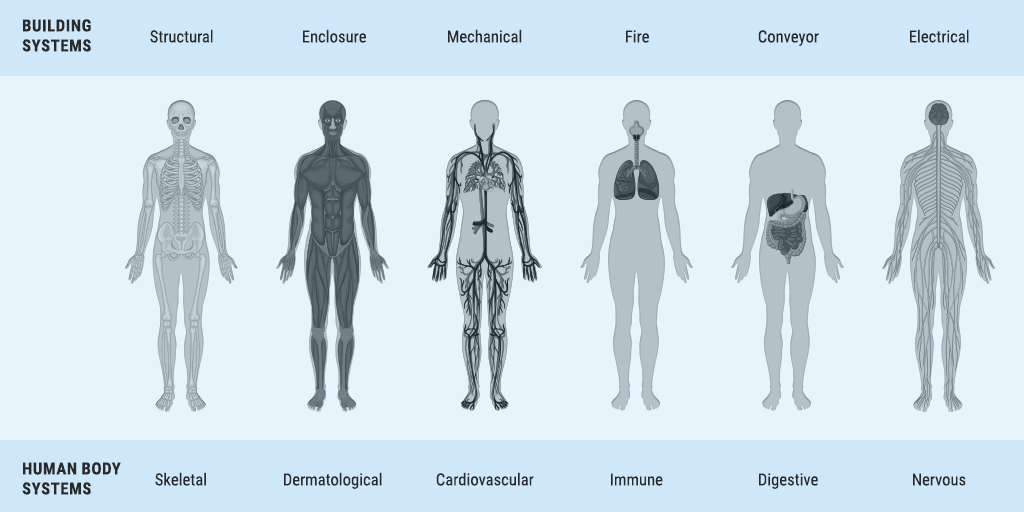As human beings, we are intimately familiar with our own bodies and the way they function. However, have you ever stopped to think about how the design of buildings can be related to the human body? Surprisingly, when we analyze the systems in a building, we can find clear analogies between their systems and those found in the human body.
In this blog, we will explore these analogies in more detail, and how they can be analogous to understand the BIM process.
Here we can consider the six distinct types of systems in both, human body, and a building as shown below.
| Building Systems | Human Body Systems |
|---|---|
| Structural System | Skeletal System |
| Enclosure System | Dermatological System |
| Mechanical System | Cardiovascular System |
| Fire Protection | Immune System |
| Conveyor System | Digestive System |
| Electrical System | Nervous System |
Comparing Building Structural System to Human Skeletal System
| Building Structural System | Human Skeletal System |
|---|---|
| The primary function is to provide strength, durability, load transfer to ground, and other properties. | The primary function is to support the body and provide a framework for movement. |
| Consists of concrete, iron, steel, and other materials. | Consists of all the bones, cartilage, tendons, and ligaments in the body. |
Both systems supply strength. The human skeletal system provides strength and motion to the body, while the building structural system provides strength and stability to the building.
Analogy of Building Enclosure System with Human Dermatological System
| Building Enclosure System | Human Dermatological System |
|---|---|
| The outer layer of a building that also acts as a protective barrier against the external environment. | The outer layer of the human body forms the dermatological system. |
| Consists of foundation, walls, roof, and windows, which work together to protect the building from weather, moisture, and energy loss. | Consists of skin, hair, nails, and glands. These organs are first line of defence against bacteria and helps to protect from injury and sunlight. |
Both systems also regulate the temperature. The human dermatological system regulates body temperature by sweating or shivering, while the building enclosure system regulates the internal temperature of a building by insulating it from external temperature changes.
Building Mechanical System versus Human Cardiovascular System
| Building Mechanical System | Human Cardiovascular System |
|---|---|
| It circulates air and water throughout the building. E.g., HVAC, Plumbing | It makes sure that body gets oxygen, nutrients, and other things it needs and gets rid of things it doesn’t. |
| This uses mechanical pumps to circulate fluids. | Day and night the heart acts as a pump and moves blood through the body. |
Both systems involve the pumping of fluid, water, air, etc., the human cardiovascular system maintains the optimum condition of the body, while the building mechanical system maintains water and air circulation in the building.
Analogy of Building Fire Protection System with Human Immune System
| Building Fire Protection | Human Immune System |
|---|---|
| It is designed to detect and prevent the spread of fire within a building. | It protects the body from pathogens and other harmful substances. |
| Consist of smoke detectors, fire alarms, sprinkler systems, and other devices that work together to detect and extinguish fires before they can cause significant damage. | Consists complex network of cells, tissues, and organs that work together to protect the body from pathogens. |
In both cases, the systems are designed to detect and respond to threats to protect the system, whether that is a human body or a building.
Comparing Building Conveyor System to Human Digestive System
| Building Conveyor System | Human Digestive System |
|---|---|
| Mechanical system that is used to transport materials or goods from one point to another in a building. | A complex biological system that breaks down food into nutrients that the body can use for energy, growth, and repair. |
| Consists of a conveyor belt, rollers, motors, sensors, and other mechanical components that work together to move the items along the belt. | Consists of various organs, including the mouth, stomach, small intestine, large intestine, rectum, and anus. |
While both systems involve the movement of materials, the human digestive system is a biological process that involves the breakdown of food for energy, while the building conveyor system is a mechanical process that involves the movement of physical objects.
Comparing Building Electrical System to Human Nervous System
| Building Electrical System | Human Nervous System |
|---|---|
| A network of wires, circuits, and electrical devices that supply and distribute electricity throughout a building. | It functions to receive, process, and transmit information through electrical impulses. The brain acts as the central processing unit, while the nerves act as the communication channels. |
| Consists of power source, and electrical panels, switches, outlets, and appliances. | Consists of brain, spinal cord, and nerves that extend throughout the body. |
While both systems involve electrical impulses, the human nervous system’s main purpose is to send and receive messages to the body parts, while the building electrical system’s main purpose is to distribute electricity as per requirements through electrical panels, and switches.
BIM Process and the Human Body: Understanding the Analogies
Building Information Modeling (BIM), according to the National BIM Standard-United States (NBIMS-US), refers to a computerized depiction of the structural and operational features of a building or facility.
BIM Coordination and Clash Detection, Revit Family Creation, MEP-FP Modeling and Detailing, Facility Management, etc. form the BIM process.
By comparing the systems in a building with those found in the human body, we can gain a deeper understanding of how these systems work together to create a functional and efficient whole.
| BIM Process | Human Body |
|---|---|
| Building systems require BIM process to build any infrastructure, which coordinate properly with other systems like mechanical, electrical, plumbing and fire protection. | The human body requires proper food with nutrition, air & water to function body properly. |
The BIM process ensures that all the trades coordinate with each other effectively and identify clashes virtually. BIM facilitates the utilization of a unified 3D model by all involved parties, including architects, surveyors, engineers, contractors, and building owners. This ensures that pertinent information is accessible to everyone at the appropriate stages throughout the project’s design and construction processes.
Conclusion
Ultimately, the human body systems like Skeletal System, Cardiovascular System, Nervous System, etc., are well connected to each other body systems to perform any operation. Similarly, the building systems like Structural System, Electrical System, Mechanical System, Fire Protection, and Conveyor System are well-coordinated through the BIM process to build any infrastructure efficiently.





